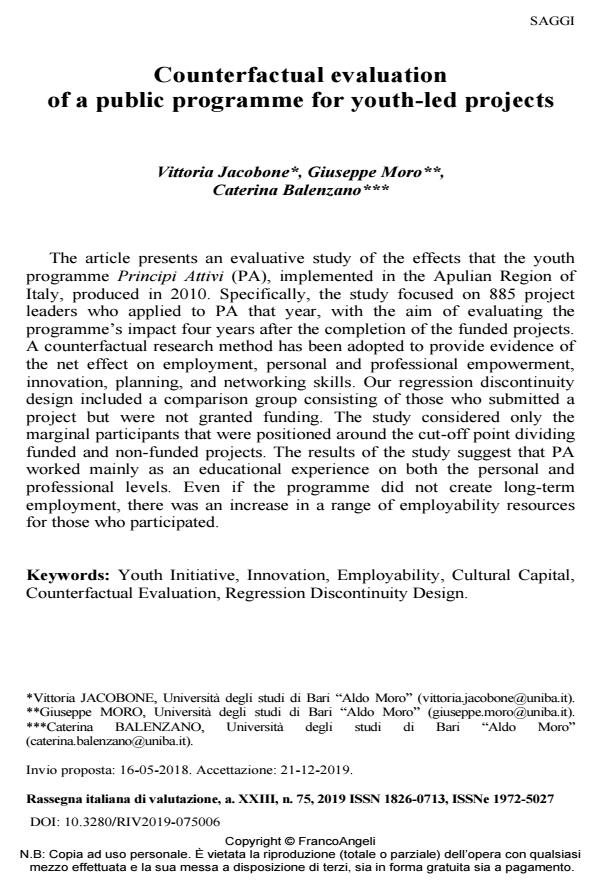Counterfactual evaluation of a public programme for youth-led projects
Titolo Rivista RIV Rassegna Italiana di Valutazione
Autori/Curatori Vittoria Jacobone, Giuseppe Moro, Caterina Balenzano
Anno di pubblicazione 2021 Fascicolo 2019/75
Lingua Italiano Numero pagine 29 P. 87-115 Dimensione file 530 KB
DOI 10.3280/RIV2019-075006
Il DOI è il codice a barre della proprietà intellettuale: per saperne di più
clicca qui
Qui sotto puoi vedere in anteprima la prima pagina di questo articolo.
Se questo articolo ti interessa, lo puoi acquistare (e scaricare in formato pdf) seguendo le facili indicazioni per acquistare il download credit. Acquista Download Credits per scaricare questo Articolo in formato PDF

FrancoAngeli è membro della Publishers International Linking Association, Inc (PILA)associazione indipendente e non profit per facilitare (attraverso i servizi tecnologici implementati da CrossRef.org) l’accesso degli studiosi ai contenuti digitali nelle pubblicazioni professionali e scientifiche
The article presents an evaluative study of the effects that the youth programme Principi Attivi (PA), implemented in the Apulian Region of Italy, produced in 2010. Specifically, the study focused on 885 project leaders who applied to PA that year, with the aim of evaluating the programme’s impact four years after the completion of the funded projects. A counterfactual research method has been adopted to provide evidence of the net effect on employment, personal and professional empowerment, innovation, planning, and networking skills. Our regression discontinuity design included a comparison group consisting of those who submitted a project but were not granted funding. The study considered only the marginal participants that were positioned around the cut-off point dividing funded and non-funded projects. The results of the study suggest that PA worked mainly as an educational experience on both the personal and professional levels. Even if the programme did not create long-term employment, there was an increase in a range of employability resources for those who participated.
Parole chiave:Youth Initiative, Innovation, Employability, Cultural Capital, Counterfactual Evaluation, Regression Discontinuity Design
- L'efficacia delle azioni di contrasto alla povertà educativa: dal mito del controfattuale alla tailoring evaluation Caterina Balenzano, in RIV Rassegna Italiana di Valutazione 79/2022 pp.95
DOI: 10.3280/RIV2021-079006
Vittoria Jacobone, Giuseppe Moro, Caterina Balenzano, Counterfactual evaluation of a public programme for youth-led projects in "RIV Rassegna Italiana di Valutazione" 75/2019, pp 87-115, DOI: 10.3280/RIV2019-075006